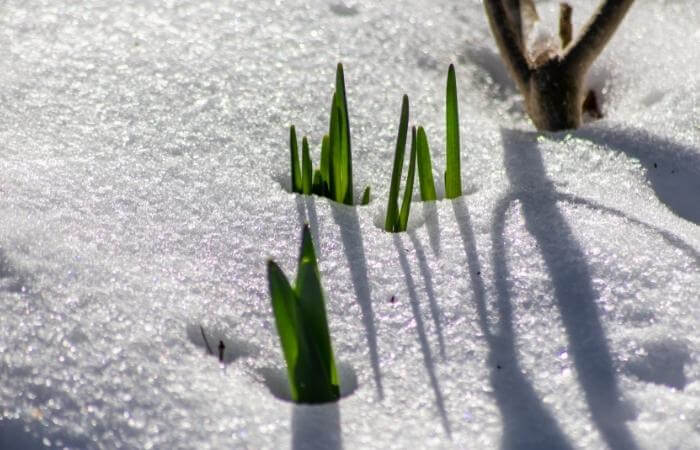Creating a beautiful outdoor garden is a source of pride, but keeping plants alive through winter can be challenging.
Snow, ice, and deep freezes can hit unexpectedly, killing off or damaging your plants, leaving you with more work and expense to replace or revive them come spring.

The best solution to keep outdoor plants alive during winter is to protect them using the various options I highlight in this guide.
Yes, you can overwinter your garden plants safely, so stay right here to learn how!
How To Protect Plants In Winter
Here are the top ways to protect outdoor garden plants in winter:
Select Zone Hardy Plant Varieties
One of the simplest ways to keep garden plants alive during winter is to choose varieties that grow best in your region.
Locate your USDA plant hardiness zone and buy landscaping plants suitable to your area.
Native plant species have the greatest chance of winter survival as they have the genetics to withstand local weather and pests.
Bring Plants Indoors
If you have garden plants that aren’t cold-weather hardy, you can bring them indoors during the winter to keep them alive.

Potted garden plants are the easiest to move to a protected garage, sunroom, greenhouse, shed, or basement.
You can also dig out plants in your garden that aren’t strong enough to withstand winter chills and move them indoors in pots until the spring thaws.
Provide plants you move indoors with adequate sunlight, warmth, water, and nutrition. Keep plants away from air vents, as they can quickly dry out the soil.
Add More Mulch In Late Fall
Mulching is a little-known way to help outdoor plants survive the winter.
Adding six inches of mulch around the base of plants out to the drip line of the foliage will ensure the soil under the mulch retains more heat, so roots are less likely to freeze.
A thick layer of mulch generates heat as it decomposes, aiding in keeping the ground around your plants warmer in winter and will leave nutrients behind as an additional bonus.
Insulate Outdoor Pots
If you have potted outdoor plants too large or heavy to move indoors, you can instead protect them with an insulating material to get them safely through the winter months.
Many people choose to save bubble wrap during the year and wrap the outside of pots with several layers and tie it off around the stem to keep warm air inside.
Create Individual Plant Covers
If you have outdoor plants that aren’t too large, you can create individual covers for them using polythene sheeting, fabric, or cardboard.
Recycling cardboard boxes is ideal for overnight or short-term shelters, but they will disintegrate if they get wet.
If the plant is slim, you can use a tall cane garden stake, tomato cage, or wire garden mesh as a structure and wrap the material around the outside.

Polythene plant covers are better than an open weave fabric material because it allows sunlight in for more heat.
Remove heavy plant cover fabrics during the daytime if temperatures climb above freezing to keep plants from suffocating.
Build A Garden Plant Shelter
For planter beds, it’s often easier to build inexpensive wood framing around the whole area and use it with a plant covering material when the temperatures plummet.
For low-growing plants, you can install garden or greenhouse hoops and drape over a fabric plant cover and use a stake to secure them to the ground.
For wood framing, place a pole upright every four feet around the garden perimeter, lay the fabric over the structure, and secure it at ground level.
If your area has cold winds from one direction, you can build a temporary screen or wall in front of your planters to buffer your plants yet allow access to sun and rain.
Apply An Anti-Transpirant Spray
Many homeowners new to gardening might not know about the benefits of anti-transpirant spray.
The spray application is easy and fast. The formula leaves behind a transparent layer over the foliage to stop plants from drying out due to moisture loss, windburn, sunscald, or salts that may splash from roads, sidewalks, or driveways.
It’s best to apply an anti-transpirant spray to garden plants in the late fall. Protection from the spray lasts about three months, which should get most plants through the winter season.
Keep Plant Canopies Clear Of Snow
After a snowfall, go around your yard and knock any accumulation off tree or shrubbery branches with a broom.
Snow can be heavy, pulling or breaking branches, leading to plant injuries that impede growth or cause sores where pests or diseases can enter.
If a branch is struggling under the weight of ice or snow you can’t remove, make a wood prop to give it extra support until it melts.
Wrap Tree Trunks
Young trees have a better chance of winter survival if you wrap the trunk or paint it with whitewash to reflect the sun and protect against wind.
A few layers of burlap or tree protection cloth wrap is another easy way to help tender saplings survive winter weather and the winds, snow, ice, and road salts that come with it.
Do You Water Plants In Winter?
Yes, you need to water plants in winter, but on a much less frequent schedule.
Most plants will need some water every 10-14 days if there is no rain or snowmelt to provide moisture to the roots. You don’t need to drench the ground, but you need to ensure it isn’t frozen before you start.
Always water at the plant’s base to avoid getting water on the foliage, which can cause freeze-burn if temperatures drop suddenly and it turns into ice.
Dry soil in any season of the year will dehydrate plants, which weakens them. Even if plants look dormant, there is still activity happening under the ground within the root system.
The roots need water to utilize stored nutrients and keep the plant alive until temperatures rise.
Winter watering is essential to help garden plants reach the warmer spring weather in more robust conditions.
Why Do Plants Die In The Winter?
Plants will die in the winter due to their roots getting too cold and remaining that way for too long.
Ice crystals form in the cells when freezing moisture in the roots or foliage occurs and expand and breaks the thin membrane walls. This cell damage prevents the plant from transporting nutrients and water it needs for growth once it comes out of dormancy.
You can observe this root or foliage damage after a frost when leaves turn a dark green or black and look saggy and waterlogged.
Plants have natural safety mechanisms to help prevent this type of cell damage from occurring, which is why it takes several hours of below-freezing weather to kill a plant.
It’s best to give any plants that appear dead a month or so in spring to see if they surprise you with new growth because many are very resilient.
In Summary
Outdoor plants can survive winter when you choose suitable species for your region and use protective measures to stop the cold, wind, salt, snow, ice, and intense UV rays from reaching plant foliage and roots.
I hope this guide to winter garden plant protection helps you keep all your plants alive during the cold months, so your yard and landscaping can burst with healthy trees, shrubs, perennials, and evergreens the rest of the year!










